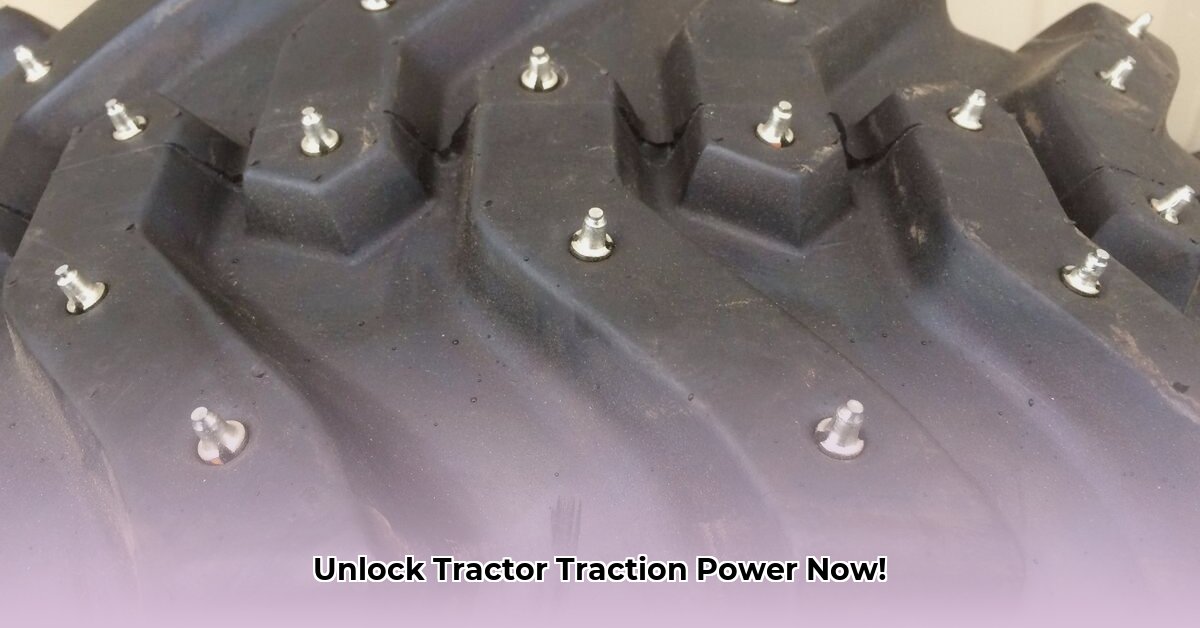
Mud, snow, and ice can bring farming to a standstill. But what if you could maintain productivity, even in the harshest conditions? Adding studs to your tractor tires offers a powerful solution, dramatically increasing traction and keeping you moving. This comprehensive guide covers everything from choosing the right studs to installation, maintenance, and troubleshooting. Whether you're a seasoned farmer or just starting out, read on to unlock the full potential of your tractor. For information on tire changes, see our guide on tire maintenance.
Understanding Tractor Tire Studs: The Grip Boosters
Tractor tire studs are metal pins inserted into your tires to significantly improve traction. Imagine tiny cleats providing extra bite, dramatically increasing surface contact with the ground. This is crucial in muddy fields, snowy winters, and icy conditions, preventing wheel spin and maximizing productivity which is key to reducing costly downtime. They're particularly beneficial for heavy-duty tasks like plowing, logging, and hauling in challenging terrain.
Types of Tractor Tire Studs
Several factors define the ideal stud for your needs:
Material: Steel studs offer a cost-effective solution, providing excellent traction for most applications. Carbide studs, while more expensive, are exceptionally durable and last much longer in harsh conditions. The choice depends on your budget and the frequency of use in challenging terrain.
Size: Stud length impacts grip; longer studs excel in deep mud, while shorter studs are sufficient for lighter snow or ice. Improper sizing can compromise traction or damage your tire.
Installation Method: Studs can be screw-in or press-in. Screw-in studs generally offer a more secure fit, while press-in studs might be easier to install with the right tools.
Choosing the right stud type depends on the specific conditions you face and the performance level required. For frequent use in extremely challenging conditions, the superior durability of carbide studs can justify their higher cost.
Choosing the Right Studs: A Tailored Approach
Selecting the right studs requires careful consideration:
Tire Size: The stud's length must match your tire's tread depth. A stud that's too short won't provide sufficient grip, while one that's too long can damage the tire. Consult your tire's specifications or a tire professional for guidance.
Terrain Type: Deep mud necessitates longer, more aggressive studs, while lighter snow or ice might only need shorter ones. Consider your typical working conditions; clay soil demands different studs than icy conditions.
Tractor Usage: Heavy-duty work requires tougher studs compared to lighter tasks. Frequent use justifies investing in higher-quality, more durable studs.
Careful selection prevents costly mistakes and ensures optimal performance.
Installing Tractor Tire Studs: A Step-by-Step Guide (Professional Installation Recommended)
While the following steps are provided for informational and experienced user purposes, professional installation is strongly recommended. Improper installation can cause tire damage or compromise safety. If you choose to proceed independently, please exercise extreme caution.
Step-by-Step Installation (For Experienced Users Only):
Thorough Cleaning: Clean the tire surface meticulously, removing all dirt, debris, and foreign materials. This ensures secure stud placement.
Strategic Marking: Plan stud placement for even wear and optimal traction. Mark the tire clearly to indicate each stud's location using a marker.
Careful Installation: Use the appropriate tool (a stud gun or manual installer) to firmly insert each stud. Ensure each stud is seated correctly and evenly.
Post-Installation Inspection: After installation, carefully inspect all studs for secure seating and even spacing. Address any misaligned or loose studs immediately.
Safety Precautions: Always wear safety glasses and work gloves during installation. Follow the manufacturer's instructions for your chosen installation tool precisely.
Stud Maintenance and Replacement: Prolonging Stud Life
Regular inspection is crucial for long-term stud and tire health. Check your studs frequently for wear and tear; worn or damaged studs must be replaced promptly to prevent tire damage or equipment failure. Remember, proper inflation pressure is paramount for even tire wear and optimal performance.
For removal, use the appropriate tool (a stud puller or similar) to prevent tire damage. Rough removal can lead to unnecessary tire and rim damage.
Troubleshooting Common Stud Issues
Several issues may arise with tire studs. Many result from improper installation or maintenance.
Uneven Stud Wear: This often indicates problems with tire inflation or wheel alignment.
Stud Loss: Missing studs usually indicate poor installation, excessive wear, or damage from hitting obstacles.
Tire Damage: This points to incorrect stud selection or installation.
Addressing these issues immediately prevents further problems and maintains tire integrity.
Weighing the Pros and Cons: Is Studded Traction Worth It?
Like any modification, tire studs present benefits and drawbacks:
| Advantages | Disadvantages |
|---|---|
| Significantly improved traction | Increased tire wear and tear |
| Enhanced safety | Potential damage to paved surfaces |
| Increased productivity | Higher initial cost |
| Reduced wheel slippage and fuel consumption | More complex installation and maintenance |
The decision depends on your specific needs and conditions. For farmers frequently operating in challenging terrain, the benefits typically outweigh the costs.
Conclusion: Drive with Confidence
Investing in tractor tire studs can significantly improve your tractor's performance, safety, and efficiency, especially in challenging conditions. Remember, proper stud selection, installation, and maintenance are key to maximizing their benefits. Don't let mud, snow, or ice slow you down – drive with confidence knowing you've maximized your tractor's grip.